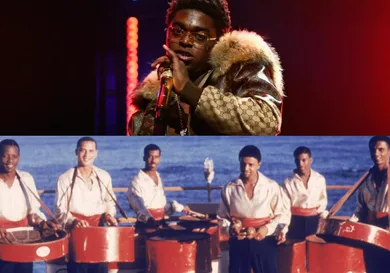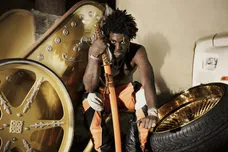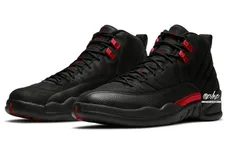By now, you’ve probably heard “ZEZE,” the tropical banger that marks Kodak Black’s second track since his release from prison. It’s production, by way of D.A. Doman, has a distinct island feel with the steel drum playing heavily into the song’s composition. The cover art depicts as much, with the ski-mask-wearing Kodak perched atop a secluded miniature island, backed by palm trees. The steel pan, or drum, as it is more commonly known, has a storied history, but it isn’t discussed in casual rap conversations nearly as much as instruments like 808s and hi-hats. It’s unique sound makes it instantly recognizable in songs such at 50 Cent’s 2003 hit “P.I.M.P,” and Travis Scott and Young Thug’s 2016 collaboration “Pick Up the Phone.” It's an instrument that can be used as an alternative to piano melodies, and one which we’ve seen on an upwards trend in hip-hop. But where did the steel drum come from?
The island vibes you associate with the instrument’s ethereal, hollow tones aren’t by mistake. Its roots can be traced back to late 1700s Trinidad. The slaves in the area developed a response to the carnival culture that came along with the French colonists, the slaves' celebrations often propelled by “drum music.” When the slaves were freed in 1834, the celebrations became rowdier, but British rule would soon crack down on these traditions, for no reason other than to quell spirits. A ban on tamboo-bamboo (bamboo sticks that were used to pound together and create sound by beating against the ground) in 1934, saw the steel pan emerge as the island’s de-facto instrument. The pans were constructed from scrap metal that was lying around, primarily old steel drums that formerly held oil. Grooves were carefully hammered into the drums to give each indent a particular pitch. While the traditional iteration of these instruments is used today, the sounds we hear in hip-hop tracks are primarily synthesized versions.
The instrument’s trek to hip-hop took several decades. The emergence of reggae in Jamaica during the sixties and the work of Bob Marley certainly helped the sound further establish its island reputation across continents. By the 1970s, Reggae had become so popular that it was only a matter of time before the steel drum would be adopted by Western artists. The late Prince would be one of the first to experiment with the sound, albeit crudely, in his 1986 track “New Position.” The production of the song indicated that it could be used to make a more innovative sound.
The rap game would take notice about a decade later, when Big L and Tupac recorded “Deadly Combination” in 1994. In this case, the steel drum melody, a high-pitched descension through out the track, creates a 90s West Coast feel and bounce. “Deadly Combination” clearly shows one of the most popular uses of the instrument, and how it would be utilized in the future, too-- that “West Coast bounce” is, by nature, summer-y. It’s reminiscent of warm weather, and it creates that distinct feeling of vacation.
“Deadly Combination,” despite being recorded in 1994, wouldn’t find its way to listeners until 2000, when both rappers had passed away. A year before, in 1999, Nas used the steel drum in “Money is My Bitch.” The song is composed in a similar fashion to “Deadly Combination,” the steel drum sided with a slapping bass and reliable shaker. At times the beat feels noticeably similar to the note progression in 50’s “P.I.M.P.,” serving as something of a bridge between late 90s hip-hop and the gangster rap of the early 2000s. “Money is My Bitch” is arguably the first mainstream rap release with the steel drum as a song’s melodic backbone, but didn’t feature the instrument as heavily as a pair of Clipse tracks that were to follow.
Clipse‘s 2003 track “I’m Not You” opens with a monologue and steel drum crescendo that gradually takes over the beat. The instrument quickly departs, however, and the song relies on more common production tropes with low synths. The duo's 2006 outing “Wamp Wamp (What It Do)” feels more confident in its use of the instrument, but tangles it up with shakers and snares. It’s clear that an island vibe was the goal, especially considering the beach-themed video, but the track didn’t necessarily embrace the full melodic potential of the steel drum. Even the Reggae tracks of the 1970s put the instrument in the background, using a funk guitar riff to carry the melody instead.
Outside of “P.I.M.P,” most listeners recall the instrument’s heavy role in Soulja Boy’s eponymous hit “Crank That” from 2007. The steel pan is really the only constant on the production end of things, minus the occasional riser, bass hit, and smattering of hi-hats. Yet despite the simple composition, the song achieved viral success with the masses, becoming one of the most recognizable tracks in hip-hop. These, and a few other tracks, created a ripple, not a wave. The piano is still heavily favored in production, with the steel drum seen as something of a novelty. Even so, the steel drum has proven capable of fostering success: “P.I.M.P.” reached number three, and “Crank That” took the top spot on Billboard’s Hot 100.
Since the onset of the 2010s, there has arguably been more releases with the steel pan taking center stage. 2012 saw Big Sean’s “Guap,” Drake’s “Take Care,” and Cash Out’s “Cashin Out” featuring instrumentals that favored the unmistakable chime. The increased use of the steel pan could be attributed to the growing popularity of Carribean music, as a whole, in the past decade. Jamaican and dancehall influences have played heavily into mainstream hip-hop music over the past couple of years: tracks like Beyonce’s “Hold Up,” Drake’s “One Dance” and “Controlla,” Tory Lanez’s “Luv.” It makes sense that a central instrument to that genre - the steel pan - would find its way to hip-hop producers, as those beatsmiths now look to emulate Island music. Consider the rise of trap music: which saw, by extension, an increased use of triplet hi-hats, punchy snares and low basslines. While the steel pan won’t necessarily create its own sub-genre of rap (or will it?), it will likely see even more infiltration into hip-hop as the Island influence continues to swell.







